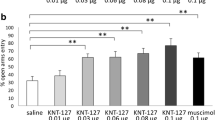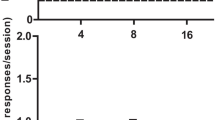Abstract
Rationale
Opioid receptors are implicated in the regulation of motivation and emotion. However, animal studies show that activation of κ opioid receptor produces contrasting mood-altering effects in models of anxiety-like and depressive-like behaviors, and consequently, the role of κ receptor in mood control remains unsettled. The effect of κ/μ opioid combination in emotion regulation was unexplored.
Objectives
The aim of the study was to investigate the effects of (-)-3-N-ethylaminothiazolo [5,4-b]-N-cyclopropylmethylmorphinan hydrochloride (ATPM-ET), a novel κ agonist and μ partial agonist, in regulating emotional responses.
Methods
The emotional responses of ATPM-ET were detected in the elevated plus maze (EPM), open field test (OFT), forced swim test (FST), and tail suspension test (TST). Selective κ antagonist nor-binaltorphimine (nor-BNI) and μ antagonist β-funaltrexamine (β-FNA) were applied to determine the type of receptor involved. The conditioned place aversion model was used to evaluate the effects on aversive emotion.
Results
In the EPM and OFT, ATPM-ET (1 and 2 mg/kg, s.c.) significantly increased the time spent in the open arm and in the central area, respectively. In the FST and TST, ATPM-ET (0.5 and 1 mg/kg, s.c.) significantly reduced the duration of immobility. These effects were prevented by nor-BNI (10 mg/kg, i.p., −24 h), but not by β-FNA (10 and20 mg/kg, i.p., −24 h) pretreatment. At the dose of 2 mg/kg, ATPM-ET did not induce conditioned place aversion.
Conclusions
ATPM-ET, at doses from 0.5 to 2 mg/kg, produced anxiolytic- and antidepressant-like effects without inducing aversive emotion. These effects were more closely mediated by activation of κ receptor than μ receptor.






Similar content being viewed by others
References
Archer S, Glick SD, Bidlack JM (1996) Cyclazocine revisited. Neurochem Res 21:1369–1373
Bahi A (2013) Individual differences in elevated plus-maze exploration predicted higher ethanol consumption and preference in outbred mice. Pharmacol Biochem Behav 105:83–88
Beardsley PM, Howard JL, Shelton KL, Carroll FI (2005) Differential effects of the novel kappa opioid receptor antagonist, JDTic, on reinstatement of cocaine-seeking induced by footshock stressors vs cocaine primes and its antidepressant-like effects in rats. Psychopharmacology (Berl) 183:118–126
Berrocoso E, Ikeda K, Sora I, Uhl GR, Sanchez-Blazquez P, Mico JA (2013) Active behaviours produced by antidepressants and opioids in the mouse tail suspension test. Int J Neuropsychopharmacol 16:151–162
Bodkin JA, Zornberg GL, Lukas SE, Cole JO (1995) Buprenorphine treatment of refractory depression. J Clin Psychopharmacol 15:49–57
Braida D, Capurro V, Zani A, Rubino T, Vigano D, Parolaro D, Sala M (2009) Potential anxiolytic- and antidepressant-like effects of salvinorin A, the main active ingredient of Salvia divinorum, in rodents. Br J Pharmacol 157:844–853
Bruchas MR, Land BB, Lemos JC, Chavkin C (2009) CRF1-R activation of the dynorphin/kappa opioid system in the mouse basolateral amygdala mediates anxiety-like behavior. PLoS One 4, e8528. doi:10.1371/journal.pone.0008528
Bruchas MR, Land BB, Chavkin C (2010) The dynorphin/kappa opioid system as a modulator of stress-induced and pro-addictive behaviors. Brain Res 1314:44–55
Carlezon WA Jr, Beguin C, DiNieri JA, Baumann MH, Richards MR, Todtenkopf MS, Rothman RB, Ma Z, Lee DY, Cohen BM (2006) Depressive-like effects of the kappa-opioid receptor agonist salvinorin A on behavior and neurochemistry in rats. J Pharmacol Exp Ther 316:440–447
Carr GV, Lucki I (2010) Comparison of the kappa-opioid receptor antagonist DIPPA in tests of anxiety-like behavior between Wistar Kyoto and Sprague Dawley rats. Psychopharmacology (Berl) 210:295–302
Dulawa SC, Holick KA, Gundersen B, Hen R (2004) Effects of chronic fluoxetine in animal models of anxiety and depression. Neuropsychopharmacology 29:1321–1330
Falcon E, Maier K, Robinson SA, Hill-Smith TE, Lucki I (2015) Effects of buprenorphine on behavioral tests for antidepressant and anxiolytic drugs in mice. Psychopharmacology (Berl) 232:907–915
Femenía T, Perez-Rial S, Uriguen L, Manzanares J (2011) Prodynorphin gene deletion increased anxiety-like behaviours, impaired the anxiolytic effect of bromazepam and altered GABAA receptor subunits gene expression in the amygdala. J Psychopharmacol 25:87–96
Filliol D, Ghozland S, Chluba J, Martin M, Matthes HW, Simonin F, Befort K, Gaveriaux-Ruff C, Dierich A, LeMeur M, Valverde O, Maldonado R, Kieffer BL (2000) Mice deficient for delta- and mu-opioid receptors exhibit opposing alterations of emotional responses. Nat Genet 25:195–200
Glover EM, Davis M (2008) Anxiolytic-like effects of morphine and buprenorphine in the rat model of fear-potentiated startle: tolerance, cross-tolerance, and blockade by naloxone. Psychopharmacology (Berl) 198:167–180
Gupta D, Radhakrishnan M, Thangaraj D, Kurhe Y (2014) Antidepressant and anti-anxiety like effects of 4i (N-(3-chloro-2-methylphenyl) quinoxalin-2-carboxamide), a novel 5-HT3 receptor antagonist in acute and chronic neurobehavioral rodent models. Eur J Pharmacol 735:59–67
Gupta D, Radhakrishnan M, Thangaraj D, Kurhe Y (2015) Pharmacological evaluation of novel 5-HT3 receptor antagonist, QCM-13 (N-cyclohexyl-3-methoxyquinoxalin-2-carboxamide) as anti-anxiety agent in behavioral test battery. J Pharm Bioallied Sci 7:103–108
Hang A, Wang YJ, He L, Liu JG (2015) The role of the dynorphin/kappa opioid receptor system in anxiety. Acta Pharmacol Sin 36:783–790
Jutkiewicz EM, Rice KC, Traynor JR, Woods JH (2005) Separation of the convulsions and antidepressant-like effects produced by the delta-opioid agonist SNC80 in rats. Psychopharmacology (Berl) 182:588–596
Jutkiewicz EM, Torregrossa MM, Sobczyk-Kojiro K, Mosberg HI, Folk JE, Rice KC, Watson SJ, Woods JH (2006) Behavioral and neurobiological effects of the enkephalinase inhibitor RB101 relative to its antidepressant effects. Eur J Pharmacol 531:151–159
Karp JF, Butters MA, Begley AE, Miller MD, Lenze EJ, Blumberger DM, Mulsant BH, Reynolds CF 3rd (2014) Safety, tolerability, and clinical effect of low-dose buprenorphine for treatment-resistant depression in midlife and older adults. J Clin Psychiatry 75:785–793
Knoll AT, Carlezon WA Jr (2010) Dynorphin, stress, and depression. Brain Res 1314:56–73
Knoll AT, Meloni EG, Thomas JB, Carroll FI, Carlezon WA Jr (2007) Anxiolytic-like effects of kappa-opioid receptor antagonists in models of unlearned and learned fear in rats. J Pharmacol Exp Ther 323:838–845
Knoll AT, Muschamp JW, Sillivan SE, Ferguson D, Dietz DM, Meloni EG, Carroll FI, Nestler EJ, Konradi C, Carlezon WA Jr (2011) Kappa opioid receptor signaling in the basolateral amygdala regulates conditioned fear and anxiety in rats. Biol Psychiatry 70:425–433
Kordjazy N, Haj-Mirzaian A, Amiri S, Ostadhadi S, Kordjazy M, Sharifzadeh M, Dehpour AR (2015) Elevated level of nitric oxide mediates the anti-depressant effect of rubidium chloride in mice. Eur J Pharmacol 762:411–418
Kudryavtseva NN, Gerrits MA, Avgustinovich DF, Tenditnik MV, Van Ree JM (2004) Modulation of anxiety-related behaviors by mu- and kappa-opioid receptor agonists depends on the social status of mice. Peptides 25:1355–1363
Kudryavtseva NN, Gerrits MA, Alekseenko OV, Van Ree JM (2005) Chronic cocaine injections attenuate behavioral response of kappa-opioid receptors to U-50,488H agonist. Bull Exp Biol Med 140:320–322
Kurhe YV, Radhakrishnan M, Thangaraj D, Gupta D (2014) Anti-anxiety effect of a novel 5-HT(3) receptor antagonist N-(benzo[d]thiazol-2-yl)-3-ethoxyquinoxalin-2-carboxamide (6k) using battery tests for anxiety in mice. Indian J Pharmacol 46:100–104
Kuzmin A, Madjid N, Terenius L, Ogren SO, Bakalkin G (2006) Big dynorphin, a prodynorphin-derived peptide produces NMDA receptor-mediated effects on memory, anxiolytic-like and locomotor behavior in mice. Neuropsychopharmacology 31:1928–1937
Lutz PE, Kieffer BL (2013) Opioid receptors: distinct roles in mood disorders. Trends Neurosci 36:195–206
Mague SD, Pliakas AM, Todtenkopf MS, Tomasiewicz HC, Zhang Y, Stevens WC Jr, Jones RM, Portoghese PS, Carlezon WA Jr (2003) Antidepressant-like effects of kappa-opioid receptor antagonists in the forced swim test in rats. J Pharmacol Exp Ther 305:323–330
Mesfin M, Asres K, Shibeshi W (2014) Evaluation of anxiolytic activity of the essential oil of the aerial part of Foeniculum vulgare Miller in mice. BMC Complement Altern Med 14:310. doi:10.1186/1472-6882-14-310
Naidu PS, Lichtman AH, Archer CC, May EL, Harris LS, Aceto MD (2007) NIH 11082 produces anti-depressant-like activity in the mouse tail-suspension test through a delta-opioid receptor mechanism of action. Eur J Pharmacol 566:132–136
Nyhuis PW, Gastpar M, Scherbaum N (2008) Opiate treatment in depression refractory to antidepressants and electroconvulsive therapy. J Clin Psychopharmacol 28:593–595. doi:10.1097/JCP.0b013e31818638a4
Peters MF, Zacco A, Gordon J, Maciag CM, Litwin LC, Thompson C, Schroeder P, Sygowski LA, Piser TM, Brugel TA (2011) Identification of short-acting kappa-opioid receptor antagonists with anxiolytic-like activity. Eur J Pharmacol 661:27–34
Pfeiffer A, Brantl V, Herz A, Emrich HM (1986) Psychotomimesis mediated by kappa opiate receptors. Science 233:774–776
Rogala B, Li Y, Li S, Chen X, Kirouac GJ (2012) Effects of a post-shock injection of the kappa opioid receptor antagonist norbinaltorphimine (norBNI) on fear and anxiety in rats. PLoS One 7, e49669. doi:10.1371/journal.pone.0049669
Rojas-Corrales MO, Berrocoso E, Gibert-Rahola J, Mico JA (2002) Antidepressant-like effects of tramadol and other central analgesics with activity on monoamines reuptake, in helpless rats. Life Sci 72:143–152
Saitoh A, Kimura Y, Suzuki T, Kawai K, Nagase H, Kamei J (2004) Potential anxiolytic and antidepressant-like activities of SNC80, a selective delta-opioid agonist, in behavioral models in rodents. J Pharmacol Sci 95:374–380
Shippenberg TS, Herz A (1986) Differential effects of mu and kappa opioid systems on motivational processes. NIDA Res Monogr 75:563–566
Shirayama Y, Ishida H, Iwata M, Hazama GI, Kawahara R, Duman RS (2004) Stress increases dynorphin immunoreactivity in limbic brain regions and dynorphin antagonism produces antidepressant-like effects. J Neurochem 90:1258–1268
Smith JS, Schindler AG, Martinelli E, Gustin RM, Bruchas MR, Chavkin C (2012) Stress-induced activation of the dynorphin/kappa-opioid receptor system in the amygdala potentiates nicotine conditioned place preference. J Neurosci 32:1488–1495
Steru L, Chermat R, Thierry B, Simon P (1985) The tail suspension test: a new method for screening antidepressants in mice. Psychopharmacology (Berl) 85:367–370
Sun JF, Wang YH, Li FY, Lu G, Tao YM, Cheng Y, Chen J, Xu XJ, Chi ZQ, Neumeyer JL, Zhang A, Liu JG (2010) Effects of ATPM-ET, a novel kappa agonist with partial mu activity, on physical dependence and behavior sensitization in mice. Acta Pharmacol Sin 31:1547–1552
Sun JF, Wang YH, Chai JR, Li FY, Hang A, Lu G, Tao YM, Cheng Y, Chi ZQ, Neumeyer JL, Zhang A, Liu JG, Wang YJ (2014) Pharmacological characterization and therapeutic potential for the treatment of opioid abuse with ATPM-ET, an N-ethyl substituted aminothiazolomorphinan with kappa agonist and mu agonist/antagonist activity. Eur J Pharmacol 740:455–463
Tejedor-Real P, Mico JA, Maldonado R, Roques BP, Gibert-Rahola J (1995) Implication of endogenous opioid system in the learned helplessness model of depression. Pharmacol Biochem Behav 52:145–152
Valdez GR, Harshberger E (2012) kappa opioid regulation of anxiety-like behavior during acute ethanol withdrawal. Pharmacol Biochem Behav 102:44–47
Van’t Veer A, Carlezon WA Jr (2013) Role of kappa-opioid receptors in stress and anxiety-related behavior. Psychopharmacology (Berl) 229:435–452
Vergura R, Balboni G, Spagnolo B, Gavioli E, Lambert DG, McDonald J, Trapella C, Lazarus LH, Regoli D, Guerrini R, Salvadori S, Calo G (2008) Anxiolytic- and antidepressant-like activities of H-Dmt-Tic-NH-CH(CH2-COOH)-Bid (UFP-512), a novel selective delta opioid receptor agonist. Peptides 29:93–103
Wilson MA, Burghardt PR, Ford KA, Wilkinson MB, Primeaux SD (2004) Anxiolytic effects of diazepam and ethanol in two behavioral models: comparison of males and females. Pharmacol Biochem Behav 78:445–458
Wittmann W, Schunk E, Rosskothen I, Gaburro S, Singewald N, Herzog H, Schwarzer C (2009) Prodynorphin-derived peptides are critical modulators of anxiety and regulate neurochemistry and corticosterone. Neuropsychopharmacology 34:775–785
Yoo JH, Lee SY, Loh HH, Ho IK, Jang CG (2004) Altered emotional behaviors and the expression of 5-HT1A and M1 muscarinic receptors in micro-opioid receptor knockout mice. Synapse 54:72–82
Zan GY, Wang Q, Wang YJ, Liu Y, Hang A, Shu XH, Liu JG (2015) Antagonism of kappa opioid receptor in the nucleus accumbens prevents the depressive-like behaviors following prolonged morphine abstinence. Behav Brain Res 291:334–341
Acknowledgments
We thank professor Ao Zhang, Shanghai Institute of Materia Medica, Shanghai, China 201203, for kindly providing compound ATPM-ET. This research was supported by grants 2013CB835100 and 2015CB553500 (to J.-G. L.) from the Ministry of Science and Technology of China, by grants 81130087, 91232716 (to J.-G. L.), and 81401107 (to Y.-J. W.) from the National Natural Science Foundation of China, and by grant 13JC140680 (to J.-G. L.) from the Committee of Science and Technology of Shanghai.
Author information
Authors and Affiliations
Corresponding authors
Ethics declarations
Conflict of interest
The authors declare that they have no conflict of interest.
Additional information
Qian Wang and Yu Long contributed equally to this work.
Rights and permissions
About this article
Cite this article
Wang, Q., Long, Y., Hang, A. et al. The anxiolytic- and antidepressant-like effects of ATPM-ET, a novel κ agonist and μ partial agonist, in mice. Psychopharmacology 233, 2411–2418 (2016). https://doi.org/10.1007/s00213-016-4292-z
Received:
Accepted:
Published:
Issue Date:
DOI: https://doi.org/10.1007/s00213-016-4292-z




